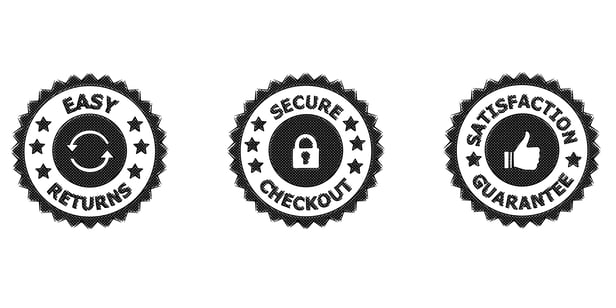Chapter 1: The Breakfast Meeting
(Following is Chapter 1 of Trust Signals: Brand Building in Post-Truth World.)
I hadn’t heard from...

(Following is Chapter 3 of Trust Signals: Brand Building in a Post-Truth World.)
Since the construction of the Pharos of Alexandria, a three- hundred-foot lighthouse on the Egyptian Nile recognized as one of the Seven Wonders of the Ancient World, lighthouses have stood for safe harbor.
Because lighthouses are built to guide sailors through dangerous storms and turbulent waters in the dark of night, it’s no wonder they have emerged as an enduring symbol of trust—as well as strength, hope, and for followers of the Christian faith, salvation.
The wood-burning flames of that ancient Egyptian structure, predecessors to beacons powered by whale oil, kerosene, and electric light that would emanate reassuringly from lighthouses for the next two thousand years, were one of the original trust signals.
Trust signals can be found almost everywhere today, if you know where to look for them.
Consider your purchase of this book, for example.
Let’s say you came across this title in a bookstore or on Amazon. You found the topic intriguing—but you’ve never heard of the author.
I’m not exactly famous, after all.
Before you buy the book, a question will inevitably cross your mind:
Can I trust this person—Scott Baradell?
Specifically, you want to know if you can trust that I have produced a work worth buying and spending your time on.
I, in turn, have attempted to prove my trustworthiness to you on the book jacket and online, by producing:
These techniques to win your trust are all examples of trust signals. While they may occur naturally—earning positive reviews for writing a great book, for example—they should never be left to chance.
And they are no different from the flames of the Pharos of Alexandria in their ultimate intent: to guide those unsure about a path to take or decision to make.
Trust signals are the points of evidence that new authors, and all of us, use to win one another’s trust.
We don’t often think about it, but we spend our whole lives disseminating and processing trust signals:
What trust signals do you seek out in others—whether it’s to make a purchase, accept a job offer, or decide to marry someone?
What signals do you send?
Becoming conscious of these signals is an important step to becoming proficient at building trust, in business and life.
In business, I define trust signals broadly, as anything that inspires confidence in your brand in the mind of your customers, employees, investors, and the general public.
Trust signals can be planned or unplanned, organic or paid, direct or subliminal. They are vital to every business: large or small, B2C or B2B, in every country and industry.
When a customer trusts your product or service, they are more likely to buy from you.If they don’t trust you, nothing else matters.
The term “trust signals” came into common parlance in the early days of internet commerce. Its definition was narrower then.
In a March 2000 article in the Journal of Computer-Mediated Communication titled, “The Role of Intermediaries in the Development of Trust on the WWW: The Use and Prominence of Trusted Third Parties and Privacy Statements,” authors Jonathan W. Palmer, Joseph P. Bailey, and Samer Faraj make the case that for ecommerce to achieve its growth potential, “developing trust between suppliers and consumers is critical” (“The Role of Intermediaries in the Development of Trust on the WWW: The Use and Prominence of Trusted Third Parties and Privacy Statements”).
The article describes the importance of displaying trust signals— in the form of endorsement seals from organizations such as the Better Business Bureau and TRUSTe (now TrustArc)—to conversion rates on ecommerce websites.
To this day, most articles covering trust signals are still written with ecommerce marketers and SEO practitioners in mind.
Search for “trust signals” on Google and the following results turn up:
Google Images results show thousands of images of trust seals that companies place on their sites to make buyers more comfortable making a purchase.

Indeed, these are all examples of trust signals.
But I would argue that to view the trust signal as simply a collection of badges to make people feel comfortable buying a product from your website is too limited a definition.
Today, not just ecommerce but all commerce is largely conducted online, thanks to the ascendancy of inbound marketing. Much of our lives are lived digitally, for that matter.
As I stated in this book’s introduction I define PR as the art of securing trust at scale.
As such, trust signals are the tools that should fill up every PR professional’s toolkit. A modern public relations agency should be able to help its clients build a path of credibility—breadcrumbs of trust—that accelerates every aspect of the marketing funnel.
Trust signals aren’t just the seals and badges that convert website visitors. They’re the evidence points consumers use to decide which websites to visit in the first place.
These evidence points might include customer reviews on review sites, featured coverage in the business press, and the endorsements of social media influencers.
All of these signals combine to drive buyers toward (or away from) your brand.
Trust signals are important to Google as well. Virtually every trust signal is a ranking factor in determining your site’s search position.
That’s why SEO professionals and software have used names like Trust Flow, TrustRank, and MozTrust to describe what they do. They know that Google is trying to determine the trustworthiness of your site, just like potential customers.
This is particularly important to Google because it is more than a search engine—it is the most powerful media company in the world. And it has a long history of battling black-hat marketers who attempt to game Google to outrank better content. That reduces the quality of results, which has made these SEO outlaws Public Enemy No. 1 for the search giant.
In 2014 Google introduced the E-A-T formula for evaluating website page quality, an acronym for expertise, authoritativeness, and trustworthiness. This formula has only grown in importance in the years since. In its most recent Search Quality Evaluator Guidelines, Google (2022) references E-A-T more than 130 times.
While I respect the formula’s sentiment, I might argue that it’s a bit redundant. Expertise and authority, after all, are two of the main signals of trustworthiness.
What Google is really saying is that it is looking for signs that your website can be trusted based on its subject matter and how other websites covering the same topic view you. This is demonstrated when those other sites mention your brand or link to you. Google also studies traffic and usage data to determine which sites best serve their visitors.
Like everything today, post-truth means different things to different people. For the purposes of this book, post-truth is simply an acknowledgment that there has been a breakdown in shared sources of truth (such as the mainstream media, government, and Big Tech), as well as the concept of objective truth.
Importantly, post-truth doesn’t equate to post-trust. It doesn’t mean there is less trust, or less of a need for trust, than in the past. I specifically take issue with those who use Stephen Covey’s term “low-trust world” to describe our current environment.
Indeed, I would argue that trust is immutable. We can’t live our lives without it—at least not in a satisfying way.
Who and what we trust, on the other hand, can vary widely. In what some would call a “low-trust” world, we may trust the government or the mainstream media less, but our friends and family more.
The post-truth era has changed who we trust, how we trust, and what makes us trust. That’s why understanding our customers and other audiences, and signaling our trustworthiness to them, is so important.
When people say we live in an era when people no longer trust each other, what they really mean is that we live in an era of trust fragmentation, because there are very few institutions the vast majority of Americans trust as part of a shared cultural identity.
In the last chapter, I told the story of an energy-company CEO who refused an interview with The New York Times because he didn’t trust it to represent his company accurately—or to reach the audience that mattered to him. In his mind, a story in the Times would be unlikely to serve as a useful trust signal for his brand.
Trust fragmentation has been happening in the United States for decades—occurring notably in the traumatic, divisive 1960s. As far back as 1979, President Jimmy Carter famously bemoaned Americans’ “growing disrespect for government and for churches and for schools, the news media, and other institutions.” Over the past forty years, this trend has only accelerated.
But this fragmentation makes the people and organizations we do trust even more important to our identity and happiness, not less.
To return to the example of Donald Trump, one reason the former president inspires such an extreme level of devotion in his followers is that they share an extreme lack of trust in institutions like the mainstream media, academia, the scientific community, and global organizations like the United Nations and NATO.
We’re not in a low-trust world, in other words. We’re in a trust multiverse.
Not to be confused with the metaverse hyped by Mark Zuckerberg and others, the multiverse is a hypothetical concept that most of us know about not from a graduate-level physics class, but from reading comic books and watching superhero movies—like Marvel’s 2022 hit Dr. Strange in the Multiverse of Madness.
Basically, it’s the idea that there are alternate, parallel, or even infinite universes rather than just our own.
To people in one universe, for example, the DC superhero Flash is a guy named Barry Allen wearing a red suit with a lightning bolt on the chest. But to people in a parallel universe, the Flash is Jay Garrick, the fellow with the silver kettle helmet.
And in your trust universe, people might believe what they hear on CNN. But in an alternate trust universe, Fox News might be gospel.
This isn’t just about politics—although brands are increasingly expected to take a stand on political and social issues today.
Politics is only one dimension of the trust multiverse. Consumers, like voters, are eschewing traditional gatekeepers in favor of an ever-expanding range of sources of “truth.”
An infinite array of trust signals.
That’s why it’s so important for every brand to know its customers well enough to understand which signals will most effectively earn their trust.
In current digital marketing parlance, a trust signal can fall into three major categories:
The next four chapters cover a comprehensive list of trust signals in each of these categories. Because there are so many website trust signals, I’ve broken them into two chapters, the first covering trust seals and the second covering the wide range of other signals your website can send.
From ancient Egyptian lighthouses to the endorsements on this book’s dust jacket, trust signals have always been with us, and are all around us today.
You just need to know where to look—and how to use them to your advantage.

Scott is founder and CEO of Idea Grove, one of the most forward-looking public relations agencies in the United States. Idea Grove focuses on helping technology companies reach media and buyers, with clients ranging from venture-backed startups to Fortune 100 companies.

(Following is Chapter 1 of Trust Signals: Brand Building in Post-Truth World.)
I hadn’t heard from...

(Following is Chapter 5 of Trust Signals: Brand Building in a Post-Truth World.)
Few things are...
Leave a Comment